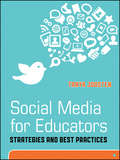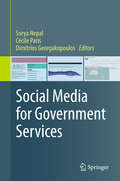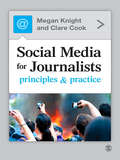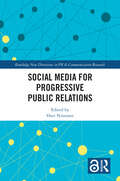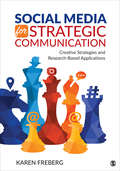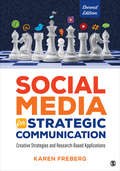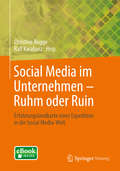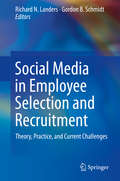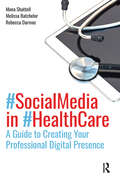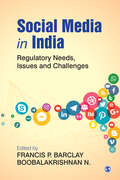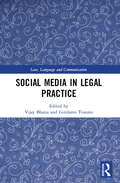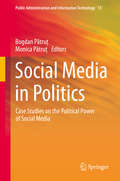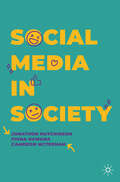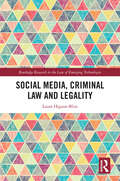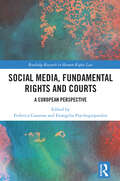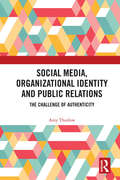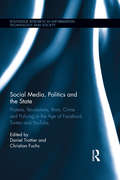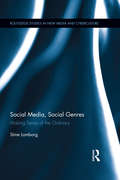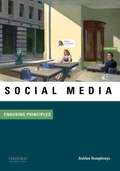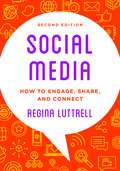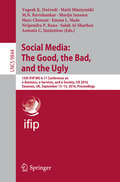- Table View
- List View
Social Media for Educators
by Tanya JoostenTap into the power of social media and increase course effectiveness! Faculty will learn to choose the appropriate social media tool for the intended learning outcome, design engaging and innovative activities, and better meet pedagogical needs. In addition, the author offers strategies for assessing and documenting the effectiveness of using these tools in your course. Administrators and student affairs professionals will also find a wealth of information useful for planning faculty development programs and communicating with students.Although the book focuses on higher education, tools and techniques presented here can be easily generalized for K-12 classrooms or organizational learning. The best practices and faculty development tips can be informative for individuals involved in any kind of professional development or network-building.
Social Media for Government Services
by Surya Nepal Cécile Paris Dimitrios GeorgakopoulosThis book highlightsstate-of-the-art research, development and implementation efforts concerningsocial media in government services, bringing together researchers andpractitioners in a number of case studies. It elucidates a number ofsignificant challenges associated with social media specific to governmentservices, such as: benefits and methods of assessing; usability andsuitability of tools, technologies and platforms; governance policies andframeworks; opportunities for new services; integrating social media with organisationalbusiness processes; and specific case studies. The book also highlights therange of uses and applications of social media in the government domain, atboth local and federal levels. As such, it offers a valuable resource for abroad readership including academic researchers,practitioners in the IT industry, developers, and government policy- anddecision-makers.
Social Media for Journalists: Principles and Practice
by Megan Knight Clare Cook"Untangles the jargon and sets out the route-map for how the social network can enable us to become major contributors to the multiplatform digital age. The right message, the right time - this is the right book for taking advantage of it all." - Jon Snow, Channel 4 News The essential guide to understanding and harnessing the tools of journalism today, Meagan Knight and Clare Cook show you how to master the enduring rules of good practice and the new techniques of social media. The book gives a thorough guide to principles and practice, including: How to find, write and break stories with social media An online journalism toolkit to get you started Using crowdsourcing to find and follow stories Getting on top of user-generated content The ins and outs of copyright and ethics Building your brand and making money The new economy of journalism and how to get ahead. More than a simple ′how-to′ guide, this book takes you to the next level with its integration of theory and practice. It is a one-stop guide for students and practitioners of journalism.
Social Media for Lawyers: The Next Frontier
by Nicole Black Carolyn ElefantAttorneys Elefant and Black provide a variety of ways for lawyers to take advantage of social media in their practice. General topics include: an overview of social media in the legal profession, why it is gaining traction with lawyers, types of social media platforms, choosing and implementing social media tools, networking and relationship building, branding and search engine optimization, getting started, best practices, and ethical and legal issues. Annotation ©2010 Book News, Inc. , Portland, OR (booknews. com)
Social Media for Progressive Public Relations (Routledge New Directions in PR & Communication Research)
by Outi NiininenThis edited book presents a comprehensive, research-led coverage of the progressive ways public relations (PR) and social media is utilised today. It offers innovative research approaches to explore PR and social media initiatives, and in so doing, provides guidance on how to direct PR communication across the complex canvas of social media where some of the communication can be highly emotional varying from overt expressions of loyalty to brandjacking. Progressive organisations are carefully engaging with their audiences in multiple social media channels with organisational goals including commercial success, sustainability or employee morale. The analytics offered by social media channels help organisations to learn about their audiences as well as design highly personalised content. This book extends our understanding of the ways PR and social media can be utilised for communication that resonates with target audiences in varying context. Through the academic research presented, readers can also learn innovative ways to investigate and improve their own PR and social media practice. The book’s main themes include the power of engagement, progressive management use of social media channels, business influence, social-influencing for non-profit causes and political impacts of targeted social media communications. Social Media for Progressive Public Relations is for scholars, researchers and students of PR and communications.
Social Media for Progressive Public Relations (Routledge New Directions in PR & Communication Research)
by Outi NiininenThis edited book presents a comprehensive, research-led coverage of the progressive ways public relations (PR) and social media is utilised today. It offers innovative research approaches to explore PR and social media initiatives, and in so doing, provides guidance on how to direct PR communication across the complex canvas of social media where some of the communication can be highly emotional varying from overt expressions of loyalty to brandjacking.Progressive organisations are carefully engaging with their audiences in multiple social media channels with organisational goals including commercial success, sustainability or employee morale. The analytics offered by social media channels help organisations to learn about their audiences as well as design highly personalised content. This book extends our understanding of the ways PR and social media can be utilised for communication that resonates with target audiences in varying context. Through the academic research presented, readers can also learn innovative ways to investigate and improve their own PR and social media practice. The book’s main themes include the power of engagement, progressive management use of social media channels, business influence, social-influencing for non-profit causes and political impacts of targeted social media communications.Social Media for Progressive Public Relationsis for scholars, researchers and students of PR and communications.Chapters 12, 13 and 14 of this book are freely available as a downloadable Open Access PDF at http://www.taylorfrancis.com under a Creative Commons [Attribution-Non Commercial-No Derivatives (CC-BY-NC-ND)] 4.0 license.
Social Media for Strategic Communication: Creative Strategies and Research-Based Applications
by Karen FrebergSocial Media for Strategic Communication: Creative Strategies and Research-Based Applications, by Karen Freberg teaches you the skills and principles needed to use social media in persuasive communication campaigns. The book combines cutting-edge research with practical, on-the-ground instruction to prepare you for the real-world challenges you will face in the workplace. The text addresses the influence of social media technologies, strategies, actions, and the strategic mindset needed by social media professionals today. By focusing on strategic thinking and awareness, it gives you the tools they need to adapt what you learn to new platforms and technologies that may emerge in the future. A broad focus on strategic communication—from PR, advertising, and marketing, to non-profit advocacy—gives you a broad base of knowledge that will serve you wherever your career may lead.
Social Media for Strategic Communication: Creative Strategies and Research-Based Applications
by Karen FrebergSocial Media for Strategic Communication: Creative Strategies and Research-Based Applications, by Karen Freberg teaches you the skills and principles needed to use social media in persuasive communication campaigns. The book combines cutting-edge research with practical, on-the-ground instruction to prepare you for the real-world challenges you will face in the workplace. The text addresses the influence of social media technologies, strategies, actions, and the strategic mindset needed by social media professionals today. By focusing on strategic thinking and awareness, it gives you the tools they need to adapt what you learn to new platforms and technologies that may emerge in the future. A broad focus on strategic communication—from PR, advertising, and marketing, to non-profit advocacy—gives you a broad base of knowledge that will serve you wherever your career may lead.
Social Media for Strategic Communication: Creative Strategies and Research-Based Applications
by Karen FrebergSocial Media for Strategic Communication: Creative Strategies and Research-Based Applications Second Edition teaches students the skills and principles needed to use social media in persuasive communication campaigns. This book combines cutting edge research with practical, on-the-ground instruction to prepare students for the real-world challenges they’ll face in the workplace. By focusing on strategic thinking and awareness, this book gives students the tools they need to adapt what they learn to new platforms and technologies that may emerge in the future. A broad focus on strategic communication – from PR, advertising, and marketing, to non-profit advocacy—gives students a broad base of knowledge that will serve them wherever their careers may lead. The Second Edition features new case studies and exercises and increased coverage of diversity and inclusion issues and influencer marketing trends. INSTRUCTORS: Your students save when you bundle Social Media for Strategic Communication, Second Edition with Freberg′s Portfolio Building Activities in Social Media, Second Edition featuring 125 real-world activities across various social media platforms. Order using bundle ISBN 978-1-0718-6142-4.
Social Media for Strategic Communication: Creative Strategies and Research-Based Applications
by Karen FrebergSocial Media for Strategic Communication: Creative Strategies and Research-Based Applications Second Edition teaches students the skills and principles needed to use social media in persuasive communication campaigns. This book combines cutting edge research with practical, on-the-ground instruction to prepare students for the real-world challenges they’ll face in the workplace. By focusing on strategic thinking and awareness, this book gives students the tools they need to adapt what they learn to new platforms and technologies that may emerge in the future. A broad focus on strategic communication – from PR, advertising, and marketing, to non-profit advocacy—gives students a broad base of knowledge that will serve them wherever their careers may lead. The Second Edition features new case studies and exercises and increased coverage of diversity and inclusion issues and influencer marketing trends. INSTRUCTORS: Your students save when you bundle Social Media for Strategic Communication, Second Edition with Freberg′s Portfolio Building Activities in Social Media, Second Edition featuring 125 real-world activities across various social media platforms. Order using bundle ISBN 978-1-0718-6142-4.
Social Media im Unternehmen – Ruhm oder Ruin: Erfahrungslandkarte einer Expedition in die Social Media-Welt
by Christine Rogge and Ralf KarabaszDer Grundsatz „Wissen ist Macht“, auf den sich Generationen von Führungskräften noch stützen konnten, ist spätestens mit dem Durchbruch der sozialen Medien passé. Informationen verbreiten sich heute im Unternehmen in Windeseile und auf immer neuen Wegen. Auch haben Mitarbeiter ganz neue Zugangswege zu Informationen. Soziale Medien erschließen ihnen zugleich die Möglichkeit, sich positiv oder negativ über das Unternehmen, seine Strategien und Führung zu äußern.Mit dem Einzug der sozialen Medien steht daher die gesamte Kommunikationskultur von Organisationen auf dem Prüfstand, wenn beispielsweise das Handeln der Führung transparenter wird und unmittelbar durch die Mitarbeiter diskutiert und bewertet werden kann. Führungskräfte sind deshalb gut beraten, sich aktiv den Herausforderungen durch das wachsende Potenzial der sozialen Medien zu stellen.Damit Unternehmen und Verwaltungen durch die Dynamik der technischen Neuerungen nicht zu Getriebenen der Entwicklungen werden, gilt es, die Auswirkungen genau zu betrachten. Erfahrungen müssen ausgetauscht werden, um Probleme frühzeitig zu erkennen und entsprechende Reaktionen erarbeiten zu können. Dazu werden in diesem Buch Beispiele aus der Praxis aufgezeigt und sowohl aus der Sicht von Führungskräften als auch von "geführten Mitarbeitern" kommentiert.
Social Media in Employee Selection and Recruitment
by Richard N Landers Gordon B SchmidtThis timely resource offers fresh research on companies'use of social media platforms--from Twitter and Facebook to LinkedIn and othercareer sites--to find and hire personnel. Its balanced approach explains why andhow social media are commonly used in both employee recruitment and selection, exploringrelevant theoretical constructs and practical considerations about theirappropriateness and validity. Contributors clarify a confusing cyberscape withrecommendations and best practices, legal and ethical issues, pitfalls andproblems, and possibilities for standardization. And the book's insights onemerging and anticipated developments will keep the reader abreast of the fieldas it evolves. Included in the coverage: · Social media as a personnel selectionand hiring resource: Reservations and recommendations. · Game-thinking within social media torecruit and select job candidates. · Social media, big data, and employmentdecisions. · The use of social media by BRIC nationsduring the selection process. · Legal concerns when considering socialmedia data in selection. · Online exclusion: Biases that may arisewhen using social media in talent acquisition. · Is John Smith really John Smith?Misrepresentations and misattributions of candidates using social media andsocial networking sites. Social Media in Employee Selection and Recruitment is a bedrock reference forindustrial/organizational psychology and human resources academics currently orplanning to conduct research in this area, as well as for academic libraries. Practitionersconsidering consulting social media as part of human resource planning orselection system design will find it a straight-talking guide to stayingcompetitive.
Social Media in Health Care: A Guide to Creating Your Professional Digital Presence
by Mona Shattell Melissa Batchelor Rebecca DarmocA practical, essential guide to social media for health care professionals, Social Media in Health Care equips readers with the skills to build their online brand, share their professional knowledge with a wider audience, and become a trusted source of information and thought leader in their field.Authors Mona Shattell, Melissa Batchelor, and Rebecca Darmoc explain the principles behind building a respected digital presence and developing meaningful online connections, while providing practical tips for navigating the five major social media platforms: Twitter, LinkedIn, Facebook, Instagram, and YouTube. Everyone from health care students to the most seasoned professionals will benefit from the 3C’s Framework outlined in the book: Consume, Contribute, and Create.Social Media in Health Care can be read cover to cover or used as quick reference guide. Topics include: Exercises for novice, intermediate, and advanced users Best practices for consuming, sharing, and creating content Tips for readers to build their social media presence and professional brand Recommendations for using digital platforms to expand professional networks Patient privacy concerns and how to avoid ethical pitfalls Social media can start conversations and serve as an open line of communication between peers, the public, and patients. Social Media in Health Care guides members of the medical community in how to use social media to help educate the public and specific patient communities about health care and health policy, make connections with industry leaders and peers, and enhance their professional reputation.
Social Media in India: Regulatory Needs, Issues and Challenges
by Francis P. Barclay Boobalakrishnan N.Social media is acutely prone to misuse—thanks to its independent and undisciplined nature—necessitating regulation. The book addresses this concern, analysing critical sociopolitical issues related to social media regulation and discussing the latest developments in India. Social Media in India: Regulatory Needs, Issues and Challenges reviews the values of freedom of expression, privacy and regulation, and proposes strategies to balance the triad, aiding policy formation, at a time when the Indian government and significant social media intermediaries are in a standoff over the newly ordained IT rules. This book covers all aspects that need to be examined for the overhaul of the regulatory framework including addiction, awareness, rampant misinformation, political applications and conflicts. Highlighting such social and user-centric challenges to the sustainability of online social networks, the book argues for the need of a robust regulatory framework and advocates an attitude adjustment about privacy and social media in the age of disinformation.
Social Media in Legal Practice (Law, Language and Communication)
by Vijay K. BhatiaThere are multiple aspects of electronically-mediated communication that influence and have strong implications for legal practice. This volume focuses on three major aspects of mediated communication through social media. Part I examines social media and the legal community. It explores how this has influenced professional legal discourse and practice, contributing to the popularity of internet-based legal research, counselling and assistance through online services offering explanations of law, preparing documents, providing evidence, and even encouraging electronically mediated alternative dispute resolution. Part II looks at the use of social media for client empowerment. It examines how it has taken legal practice from a formal and distinct business to one that is publicly informative and accessible. Part III discusses the way forward, exploring the opportunities and challenges. Based on cases from legal practice in diverse jurisdictions, the book highlights key issues as well as implications for legal practitioners on the one hand, and clients on the other. The book will be a valuable reference for international scholars in law and other socio-legal studies, discourse analysis, and practitioners in legal and alternative dispute resolution contexts.
Social Media in Politics
by Bogdan Pătruţ Monica PătruţThis volume sets out to analyse the relation between social media and politics by investigating the power of the internet and more specifically social media, in the political and social discourse. The volume collects original research on the use of social media in political campaigns, electoral marketing, riots and social revolutions, presenting a range of case studies from across the world as well as theoretical and methodological contributions. Examples that explore the use of social media in electoral campaigns include, for instance, studies on the use of Face book in the 2012 US presidential campaign and in the 2011 Turkish general elections. The final section of the book debates the usage of Twitter and other Web 2. 0 tools in mobilizing people for riots and revolutions, presenting and analysing recent events in Istanbul and Egypt, among others.
Social Media in Society
by Jonathon Hutchinson Fiona Suwana Cameron McTernanThis book is about the role that social media plays in the lives of individuals, societies, economies and polities. It therefore takes in a wide view of the emergent and changing impacts of social media platforms, and social media practices. As a consequence, it examines social media use through various intellectual and scholarly traditions --psychology, sociology, cultural studies, economics, and (national and global) politics – but it is primarily situated in the field of media and communications studies. As such, it frames its analysis of social media impacts using media studies concepts and terminology, and places media texts, forms, industries and agents (producers, audiences and other users) at the centre of each thematic chapter.
Social Media, Criminal Law and Legality (Routledge Research in the Law of Emerging Technologies)
by Laura Higson-BlissUtilising Lon Fuller’s conception of legality, this book argues that current legal provisions often used to control online abuse aided by social media do not conform to the basic principles of legality in the criminal law, in turn, threatening freedom of expression.How we regulate inappropriate behaviour online, often referred to as online abuse, particularly online abuse aided by social media, is a contemporary concern for governments across the globe. Tragedies, such as the death of a celebrity following a campaign of online abuse, often hit the headlines, followed by the same echo: there should be a law against this. Yet, in England and Wales, numerous laws exist to control, prosecute, and convict individuals who use the likes of social media to harass, intimidate, and abuse others online. So why is the law failing to keep pace with modern technology? This monograph critically examines this fundamental question, from the perspective of legality. Applying criminal law to three growing areas of concern, it covers: (1) racist speech, (2) cyberharassment/cyberstalking, and (3) the sending of abusive messages online. It then turns to examine the latest attempts by UK officials to tackle these issues through the implementation of the Online Safety Act 2023 and France’s, Germany’s, and India’s attempts to regulate social media.The book will be of interest to researchers in the field of criminal law and cyber law, as well as online abuse, harassment, and discrimination.
Social Media, Fundamental Rights and Courts: A European Perspective (Routledge Research in Human Rights Law)
by Evangelia Psychogiopoulou Federica CasarosaThis volume examines European and national higher court decisions on social media from the perspective of fundamental rights and judicial dialogue. While the challenges social media poses for public policy and regulation have been widely discussed, the role of courts in this evolving legal area, especially from a fundamental rights standpoint, has hitherto remained largely underexplored. This volume probes the contribution of national and European judiciaries to the protection of fundamental rights in a social media setting and delves into patterns of dialogue and interaction between domestic courts, the Court of Justice of the EU (CJEU) and the European Court of Human Rights (ECtHR), and between the CJEU and the ECtHR. The book specifically examines the extent and ways in which national and European judges incorporate fundamental rights reasoning in their social media rulings. It also investigates the nature and breadth of the use of European supranational case law in domestic judicial assessment, and analyses the engagement of the CJEU and the ECtHR with the other’s case law. In doing so, the book instils jurisprudential dynamics into the study of social media law and regulation, exploring in particular the effects of European constitutionalism on the shaping and enforcement of fundamental rights in a social media context. Written by emerging and established experts in the field, this book will be essential reading for scholars of comparative, European and constitutional law, as well as those with a particular interest in digital technologies and social media.
Social Media, Organizational Identity and Public Relations: The Challenge of Authenticity (Routledge New Directions in PR & Communication Research)
by Amy ThurlowPublic relations has been swift to grasp social media, yet its impact on public relations practice remains relatively unexplored. This book focusses on a way of understanding organizational identity construction in a virtual context, developing scholarship on the importance of a virtual presence in PR management, and further, to make sense of these identities as authentic, legitimate or plausible. Through a diverse group of empirical case studies, this book explores the global perspective on organizational identities which transcend global boundaries via the internet including Volkswagen’s emissions scandal and Monsanto and organized social media protests. It also explores crowdfunding – an emerging form of capitalist development constructed through sensemaking in social media. By looking at the emergence of organization in today’s social media environment, it identifies how the interactive is created on a digitally mediated platform, sharing knowledge and engaging individuals in organizational identity construction. Viewing the social construction of organizational identities through this lens, this innovative book locates how identities are plausible, authentic and legitimate - or not – through their ongoing communication via social media. It will be of great interest to academics teaching and researching in public relations, organisational communication and social media.
Social Media, Politics and the State: Protests, Revolutions, Riots, Crime and Policing in the Age of Facebook, Twitter and YouTube (Routledge Research in Information Technology and Society #16)
by Christian Fuchs Daniel TrottierThis book is the essential guide for understanding how state power and politics are contested and exercised on social media. It brings together contributions by social media scholars who explore the connection of social media with revolutions, uprising, protests, power and counter-power, hacktivism, the state, policing and surveillance. It shows how collective action and state power are related and conflict as two dialectical sides of social media power, and how power and counter-power are distributed in this dialectic. Theoretically focused and empirically rigorous research considers the two-sided contradictory nature of power in relation to social media and politics. Chapters cover social media in the context of phenomena such as contemporary revolutions in Egypt and other countries, populism 2.0, anti-austerity protests, the fascist movement in Greece's crisis, Anonymous and police surveillance.
Social Media, Social Genres: Making Sense of the Ordinary (Routledge Studies in New Media and Cyberculture)
by Stine LomborgInternet-based applications such as blogs, social network sites, online chat forums, text messages, microblogs, and location-based communication services used from computers and smart phones represent central resources for organizing daily life and making sense of ourselves and the social worlds we inhabit. This interdisciplinary book explores the meanings of social media as a communicative condition for users in their daily lives; first, through a theoretical framework approaching social media as communicative genres and second, through empirical case studies of personal blogs, Twitter, and Facebook as key instances of the category of "social media," which is still taking shape. Lomborg combines micro-analyses of the communicative functionalities of social media and their place in ordinary people’s wider patterns of media usage and everyday practices.
Social Media: Enduring Principles
by Ashlee HumphreysIntegrating the role of media in society with foundational research and theory, Social Media aims to open a well-structured, well-grounded conversation about media transition and its effects. Offering a comprehensive overview of topics, it covers not only cultural issues like online identityand community, but also tackles more analytical topics like social media measurement, network analysis, and social media economics at an introductory level.
Social Media: How to Engage, Share, and Connect,
by Regina Luttrellappropriate use of social media in public relations, where the profession stands today and where it is headed in the future; and - real-world examples of successful social media campaigns. This book will become your go-to reference guide for all things social media-related as it applies to public relations and the everyday duties of PR professionals.
Social Media: The Good, the Bad, and the Ugly
by Yogesh K. Dwivedi Antonis C. Simintiras Nripendra P. Rana Marijn Janssen Matti Mäntymäki M. N. Ravishankar Marc Clement Emma L. Slade Salah Al-SharhanThis book constitutes the refereed conference proceedings of the 15th IFIP WG 6. 11 Conference on e-Business, e-Services and e-Society, I3E 2016, held in Swansea, UK, in September 2016 The 47 full and 17 short papers presented were carefully reviewed and selected from 90 submissions. They are organized in the following topical sections: social media strategy and digital business; digital marketing and customer relationship management; adoption and diffusion; information sharing on social media; impression, trust, and risk management; data acquisition, management and analytics; e-government and civic engagement; e-society and online communities.
